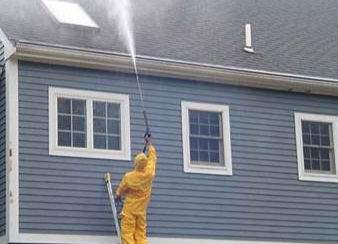DIY Pressure Washing Cleaning Solutions
- Scott Nguyen
- Feb 18
- 2 min read

As winter fades and warmer days approach, many homeowners start preparing their outdoor spaces for entertaining and family time. Cleaning your home’s exterior is a key part of this preparation, and choosing the right method can save time, effort, and potential damage.
Choosing the Right Cleaner for Your Home's Exterior: A Comprehensive Guide for DIYers
Over-the-counter cleaners like Zep House & Siding Pressure Wash Cleaner and Ecolab Exterior House & Siding Pressure Wash Concentrate Cleaner, both available at Home Depot, are popular for DIY projects. These products are designed to remove dirt, algae, mold, and mildew. However, while effective for surface-level grime, they often require high-pressure washing for thorough cleaning. This means spraying each row of siding meticulously, which is time-consuming and physically demanding, especially when using ladders to reach upper sections, sometimes 20 feet high.

Zep and Ecolab: What You Need to Know
Zep’s formula with sodium carbonate and EDTA helps remove grime and mineral deposits, while Ecolab’s nonionic surfactants and sodium hydroxide break down organic materials. These cleaners work well for seasonal dirt but are less effective on organic growth like mold and algae. High-pressure rinsing is necessary but can crack vinyl siding, splinter wood, and erode brick mortar if not handled carefully.
The Hidden Dangers of High-Pressure Washing
High-pressure washing can force moisture behind siding, leading to mold growth, wood rot, and structural damage. Window seals can also be compromised, causing leaks and energy loss. The physical demands of high-pressure washing, particularly when using ladders, increase the risk of falls and injuries.
Sodium Hypochlorite: The DIY Powerhouse Cleaner
Sodium hypochlorite, or bleach, is the most effective cleaner for mold, mildew, and algae. Found in pool shock products, it’s available in 12.5% concentration at pool supply stores in 1-gallon and 5-gallon containers. Dilute it to around 1% for safe use, remembering that most pressure washers further dilute the solution. Sodium hypochlorite not only cleans but also sanitizes, providing longer-lasting results than other cleaners.
**Important Note: None of the cleaners discussed in this guide—including Zep, Ecolab, and sodium hypochlorite—should be used on stained siding or wood decks, as they can cause damage. For these surfaces, peroxide-based cleaners are recommended, and we'll cover this in detail in a future blog post.
Soft Washing: The Preferred Method for DIYers
Soft washing uses low-pressure water and cleaning solutions like sodium hypochlorite, making it ideal for delicate surfaces like vinyl siding, wood, and painted exteriors. Key steps for DIY soft washing include proper dilution, wearing protective gear, and protecting plants from chemical exposure. Soft washing requires less physical effort, covers more area efficiently, and minimizes surface damage.
DIY Tips for Exterior Cleaning
Zep and Ecolab: Follow manufacturer instructions, use high-pressure water cautiously, and be aware of potential damage.
Sodium Hypochlorite: Mix to 1%, account for pressure washer dilution, apply evenly, and wear protective gear.
Final Thoughts for DIYers:
DIY exterior cleaning is rewarding but challenging. Store-bought cleaners have limitations, and high-pressure washing poses risks. Sodium hypochlorite and soft washing offer a safer, more effective alternative. With preparation and care, DIYers can achieve excellent results while protecting their home.

Comentários